Growing up in Scotland: a study following the lives of Scotland's children
The first research report on Sweep 1 findings of the Growing Up in Scotland study.
Chapter 5: Parental Support
5.1 Introduction
This chapter looks at sources of support that parents draw on in relation to parenting and childcare or for information and advice about child-related issues. Particular attention is given to sources of informal support and, especially, to the issue of grandparenting. Research has repeatedly shown that grandparents are a key source of childcare for many parents and that grandparents often step into parenting roles when parents are unable to care for their children for whatever reason. The Millennium Cohort Study has also confirmed parents' use of their own parents as sources of support for parenting (Owen et al. 2004).
Much of the remainder of the chapter concerns parents' knowledge and use of formal services. Both UK and Scottish government initiatives have the explicit aim of supporting parenting. These include UK policies to boost parents' and children's financial situation (e.g. Working Families Tax Credit, Child Trust Fund) and to assist work-life balance (e.g. statutory provisions on parental leave and flexible work). They also include a raft of Scottish policies and initiatives which aim to promote and develop a range of childcare, educational, health and advice services supporting child development and parenting (e.g. Sure Start Scotland, the Childcare Strategy for Scotland, Improving Health in Scotland - the Challenge, the National Programme for Mental Health and Wellbeing Action Plan). However, it has to be noted that at the local level, services are provided by voluntary as well as statutory bodies, and parents may be unaware of the relationship of many specific services to government funding or policy. The chapter examines knowledge and awareness of key initiatives aimed at helping parents and families. Data are also presented on attendance at mother and toddler/baby groups and parenting classes.
5.2 Grandparents
Grandparents are widely acknowledged as a key source of informal support for parents, especially for parents of young children. Analysis in section 1.3 showed that virtually all (99%) of the children in both samples had at least one grandparent alive at the time of the interview and over half had four grandparents alive, with a small proportion having more than four. This section examines more closely the relationship between cohort children and their grandparents and the extent to which grandparents provide help and support to parents.
5.2.1 Contact with grandparents
Most parents in both cohorts (72% of babies' parents, 69% of toddlers' parents) said they were in contact with all of the child's grandparents (either face-to-face, by phone or by letter or e-mail) with most of the rest in regular contact with at least some of them. Less than 2% of parents did not have regular contact with any of the child's grandparents. As might be expected, families where the children had fewer grandparents were more likely to be in regular contact with all of those grandparents than families where the child had more grandparents. In the baby cohort, 80% of families where the child had one or two grandparents were in regular contact with all of them compared with 71% with three or four grandparents and 60% with four or more grandparents.
Around half the children in each cohort had all of their grandparents living locally, that is within 20-30 minutes' drive of the child's home; 37% had some of their grandparents living locally and 14% had no grandparents in the local area. In around 80% of cases where the family were in regular contact with each of the child's grandparents, all of those grandparents lived in the local area. Where fewer grandparents lived in the local area, families were less likely to have regular contact with all of them - though the data do not show whether it is actually those grandparents who live furthest away with whom contact is less.
Figure 5-A Reported frequency with which children saw their grandparents by sample type
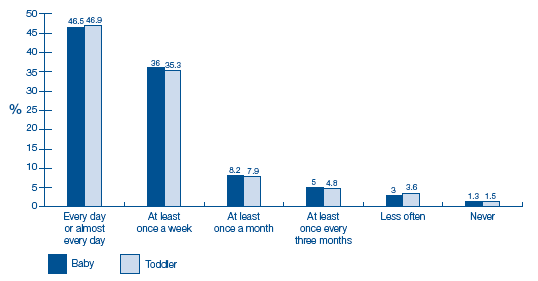
Almost half of children in both samples saw their grandparents daily or almost daily, with four out of five seeing them at least once a week or more often.
Children in lone parent families were less likely to have regular contact with all of the child's grandparents (49% compared with 77% in couple families) but more likely to have grandparents who lived locally. Only 5% of babies in lone parent families did not have a grandparent who lived locally compared with 17% in couple families. Frequency of contact was also higher in lone parent families (Figure 5-B): two-thirds (67%) of babies with lone parents saw their grandparents on a daily or almost daily basis compared with around two-fifths of babies in couple families.
Figure 5-B Reported frequency with which children saw their grandparents by family type (baby cohort only)
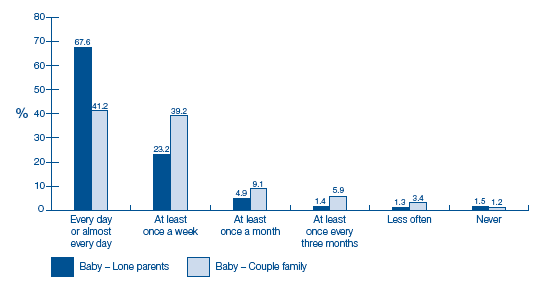
Younger mothers were less likely than older mothers to maintain regular contact with all of the child's grandparents. For example, in the toddler cohort, 79% of mothers aged 40 or over at the time of the child's birth said they kept in touch with all of the child's grandparents compared with 47% of mothers aged under 20. The greater likelihood that younger mothers will be lone parents may explain some of this difference.
But children with mothers in the oldest age group had, on average, fewer living grandparents and were also significantly less likely to have all of their grandparents living locally - in the baby cohort, around a third (32%) of children whose mothers were aged 40 or older had all their grandparents living in the local area compared with around half of those with mothers in all younger age groups.
Although less likely to have contact with all of their grandparents, children with younger mothers (especially aged 20 or under) had more frequent contact with those grandparents they were in touch with - though this is, of course, partly explained by the fact that (as noted in section 2.3.4) a quarter of children with mothers aged under 20 at the time of birth actually lived with the child's grandparents. Nonetheless, even excluding this group, the data show that as maternal age increases, the frequency of contact between children and their grandparents decreases - a quarter of babies with mothers aged 40 or older saw their grandparents on a daily or almost daily basis compared with 54% of babies whose mothers were in their twenties.
Though more likely to have all of their grandparents living locally, children living in more deprived areas were less likely than children living in less deprived areas to be in regular contact with all of their grandparents. In the toddler cohort, just over half (54%) of parents in the most deprived quintile reported that they were in contact with all of the child's grandparents, compared with 81% of those in the least deprived quintile (Figure 5-C).
Frequency of contact was also directly correlated with area deprivation levels so that babies and toddlers in more deprived areas had more frequent contact with at least some of their grandparents than children in areas with lower deprivation levels. A higher reliance on sources of informal support by parents in more deprived areas may explain why contact between children and their grandparents is more frequent in these areas.
Figure 5-C Proportion of child's grandparents with whom parent was in regular contact by sample type and area deprivation quintiles
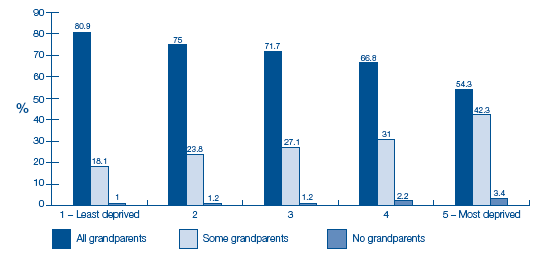
Respondents living in areas classified as remote rural were more likely than those elsewhere to report some form of regular contact with all of the child's grandparents. In the baby cohort, for example, 82% of families living in remote rural areas were in regular contact with all of the child's grandparents compared with 70% of those living in large urban areas and 74% of those living in small accessible towns. Despite children in remote rural areas being the least likely to have any grandparents living locally, these children saw their grandparents just as frequently as children living in most other urban/rural area types (Table 5.1). However, it is notable that the proportion of children who have relatively little contact with their grandparents (less than once a month) is significantly higher in remote rural areas than it is in urban areas (22% of toddlers in remote rural areas compared with 10% in large urban areas).
Table 5.1 Reported frequency with which children saw their grandparents by sample type and area urban/rural classification
| Sample type and frequency of contact |
Urban/Rural Classification |
|||||
|---|---|---|---|---|---|---|
| Large urban |
Other urban |
Small accessible town |
Small remote town |
Accessible rural |
Remote rural |
|
| Babies |
||||||
| Every day or almost every day |
45.3 |
51.3 |
46.2 |
45.3 |
39.8 |
43.4 |
| At least once a week |
35.5 |
35.3 |
40.0 |
35.6 |
38.9 |
28.3 |
| At least once a month |
9.1 |
6.2 |
7.8 |
7.8 |
10.5 |
9.8 |
| At least once every three months |
5.2 |
4.0 |
3.0 |
6.0 |
6.2 |
10.9 |
| Less often than that |
3.3 |
2.3 |
1.7 |
4.1 |
3.9 |
5.1 |
| Never |
1.6 |
0.9 |
1.3 |
1.2 |
0.7 |
2.5 |
| Bases |
||||||
| Weighted |
2048 |
1653 |
493 |
147 |
661 |
215 |
| Unweighted |
1973 |
1627 |
501 |
156 |
718 |
242 |
| Toddlers |
||||||
| Every day or almost every day |
46.7 |
47.7 |
52.2 |
54.2 |
40.6 |
43.9 |
| At least once a week |
35.5 |
37.2 |
33.1 |
32.9 |
36.5 |
23.9 |
| At least once a month |
8.3 |
6.0 |
8.3 |
4.4 |
11.0 |
10.4 |
| At least once every three months |
3.6 |
4.1 |
2.7 |
6.3 |
8.6 |
12.3 |
| Less often than that |
3.9 |
3.5 |
2.5 |
2.3 |
2.9 |
7.3 |
| Never |
2.0 |
1.5 |
1.2 |
0.4 |
2.2 |
|
| Bases |
||||||
| Weighted |
1047 |
900 |
307 |
83 |
394 |
126 |
| Unweighted |
991 |
885 |
316 |
90 |
431 |
145 |
5.2.2 Support received from grandparents
To gauge the extent and type of support offered by the child's grandparents, we asked parents a series of questions about how often the child's grandparents babysat, had the child to stay overnight, took the child out, bought toys or clothes for the child, helped out around the house and helped out financially. The results are displayed in Table 5.2.
Table 5.2 Nature and frequency of help and support from grandparents by sample type
| Nature and frequency of support |
Sample type (%) |
|
|---|---|---|
| Baby |
Toddler |
|
| Look after the child for an hour or more during the day |
||
| Every day or almost every day |
20.1 |
19.5 |
| At least once a week |
37.1 |
38.5 |
| At least once a month |
14.0 |
12.1 |
| At least once every three months |
5.4 |
5.6 |
| Less often |
4.5 |
4.7 |
| Never |
18.9 |
19.7 |
| Babysit for the child during the evening |
||
| Every day or almost every day |
2.7 |
2.8 |
| At least once a week |
15.7 |
16.2 |
| At least once a month |
28.6 |
27.1 |
| At least once every three months |
14.3 |
16.0 |
| Less often |
8.9 |
10.3 |
| Never |
29.8 |
27.6 |
| Have the child to stay overnight |
||
| Every day or almost every day |
3.5 |
2.5 |
| At least once a week |
9.3 |
11.0 |
| At least once a month |
16.1 |
18.9 |
| At least once every three months |
10.8 |
13.6 |
| Less often |
9.8 |
14.1 |
| Never |
50.5 |
40.0 |
| Take the child on outings or day trips |
||
| Every day or almost every day |
2.9 |
2.1 |
| At least once a week |
19.0 |
20.3 |
| At least once a month |
18.0 |
22.8 |
| At least once every three months |
7.6 |
13.2 |
| Less often |
6.3 |
9.6 |
| Never |
46.1 |
32.0 |
| Buy toys, clothes or equipment for the child apart from on special occasions like birthdays |
||
| Every day or almost every day |
2.5 |
2.2 |
| At least once a week |
20.9 |
19.3 |
| At least once a month |
40.7 |
36.8 |
| At least once every three months |
19.2 |
19.9 |
| Less often |
7.3 |
8.7 |
| Never |
9.4 |
13.1 |
| Help out around the house - for example by cooking, cleaning or doing DIY |
||
| Every day or almost every day |
7.4 |
5.7 |
| At least once a week |
10.3 |
10.0 |
| At least once a month |
11.3 |
8.2 |
| At least once every three months |
7.9 |
8.4 |
| Less often |
7.3 |
9.2 |
| Never |
55.7 |
58.5 |
| Help out financially in some other way |
||
| Every day or almost every day |
1.8 |
1.0 |
| At least once a week |
4.8 |
4.7 |
| At least once a month |
9.9 |
9.2 |
| At least once every three months |
10.3 |
9.0 |
| Less often |
14.3 |
16.2 |
| Never |
58.9 |
59.9 |
| Bases |
||
| Weighted |
5217 |
2858 |
| Unweighted |
5217 |
2858 |
As the table shows, grandparents helped out in a variety of ways though certain forms of support were considerably more common than others. Providing childcare during the day and buying toys, clothes or equipment for the child were the two most common activities reported by respondents. In all, around 90% of babies' parents and 87% of toddlers' parents said that the child's grandparents bought things for the child with around a quarter, for babies, and a fifth, for toddlers, doing so on at least a weekly basis. Looking after the child was the most frequent activity reported. Around four out of five (80%) parents in both cohorts said that the child's grandparents looked after the child for an hour or more during the day at least occasionally, including one-fifth where this was a daily or almost daily occurrence.
Babysitting the child in the evening and having the child to stay overnight were less common activities. Approximately 70% of parents in both cohorts said that the child's grandparents babysat on occasion although this was predominantly on a monthly or less often basis. Although on the whole there were few significant differences between the baby and toddler samples in terms of grandparental support, toddlers were more likely than babies to spend the night with their grandparents - 60% of the toddler cohort stayed with their grandparents at least sometimes, compared with 51% of the baby cohort. Helping out around the house and providing financial help were the two items grandparents were least likely to do. Less than half the parents in both cohorts said that grandparents helped out in this way.
To allow a broader examination of how the level of support from grandparents varied across the sample, as well as considering responses on individual questions, each item was converted into a scale 15 and all items added together to give an overall index of 'grandparental support'. A higher score on the index indicated a higher level of support from grandparents. Scores on the index ranged from a potential minimum of zero to a potential maximum of 35. Given the similarities between the two cohorts on each item, they were considered together for this analysis.
Overall, the analysis indicates that grandparents were involved more in the lives of children from lone parent families than those from couple families. Lone parents scored an average of 16 on the index compared with an average score of 12 for couple families. Although there were statistically significant differences between the groups on all individual items some key differences were evident in grandparents contributions via childcare, helping out around the house and helping out financially. Whilst both couple families and lone parents were just as likely to use grandparents for childcare during the day, lone parents did so on a more frequent basis than couple families. Twenty-nine percent of lone parents said that the child's grandparents looked after the child during the day on a daily or almost daily basis compared with 17% of couple families. Overnight stays with grandparents were also a more regular feature for children in lone parent families: around two-thirds (65%) of lone parents said that the child stayed overnight with their grandparents on occasion compared with half of parents in couple families. Fifty-seven percent of lone parents received some financial support from the child's grandparents, with a third (35%) doing so on a monthly or more frequent basis compared with 36% and 11% respectively for couple families.
Families where the child was the first born had a greater level of support from the child's grandparents than families who already had other children. Primaparous mothers scored an average of 14.5 on the grandparents' support scale compared with a mean score of 11.2 for multiparous mothers. Although this trend was evident on all individual items, those concerning help around the house and financial assistance showed the most similarity between the two groups and overnight stays demonstrated the largest distinction - children of primaparous mothers were more likely than children with older siblings to stay overnight with their grandparents and to do so more often.
Figure 5-D Mean score on the index of grandparental support by age of mother at birth of cohort child
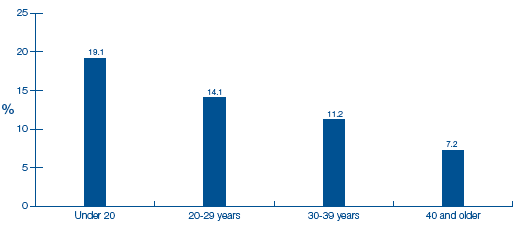
Grandparental involvement varied greatly by the age of the mother at birth (Figure 5-D). Mothers who were aged under 20 years scored an average of 19.1 on the index, almost twice as high as mothers in their thirties and three times as high as mothers aged 40 or older. The two starkest differences occurred in the extent to which grandparents had the child to stay overnight and took the child on outings or day trips. Four out of five children with a mother aged under 20 stayed with their grandparents at least sometimes compared with one in five children with a mother aged 40 or older. It is worth bearing in mind that a significant proportion of mothers in the youngest age group were living with the child's grandparents at the time of the interview thus skewing results on this particular item. However, even excluding those cases, younger mothers still scored significantly higher on the support index than older mothers.
There was some variation in the extent of grandparental support between families in urban and rural areas (Figure 5-E). Families living in areas classed as 'other urban' received more support from grandparents than families elsewhere, while those in remote rural areas scored lowest on the scale.
Looking at the individual items, it appears that whilst living in a remote or rural area did not necessarily prevent grandparents from being involved in providing support, in many cases it meant support was provided on a less frequent basis. For example, grandparents of children living in areas classed as large or other urban or small, accessible towns were twice as likely to babysit or have the child stay overnight on a weekly or more frequent basis as grandparents of children living in remote or rural areas.
Figure 5-E Mean score on the grandparental support scale by area urban/rural classification
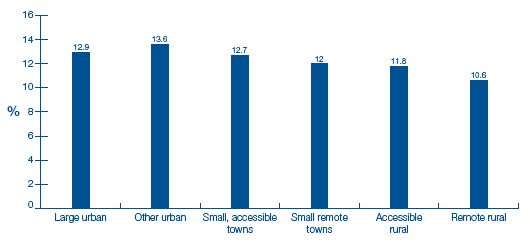
5.3 Wider sources of informal support
To explore further the extent and nature of sources of informal support available to parents, respondents were asked a range of questions about the ease with which they could arrange for someone to look after the sample child at short notice.
5.3.1 Leaving the child with someone for a couple of hours during the day
Over three-quarters of respondents in both cohorts said they would find it very or fairly easy to find someone to look after their child for a few hours during the day. There were no statistically significant differences between babies and toddlers.
Younger mothers were more likely to say they would find it easy to organise someone to look after the child for a few hours during the day. Four out of five of those who were aged under 20 at the time of the child's birth (83%) said they would find it very or fairly easy to arrange this at short notice, compared with around three out of five of those aged 40 or older. Some differences were also apparent in terms of ethnicity: 78% of white respondents said this would be easy for them to organise compared with 69% of non-white respondents.
5.3.2 Leaving the child with someone for a whole day
The majority of parents (60% in both cohorts) found it fairly or very easy to arrange for someone to look after their child for a whole day although, as might be expected, this was not considered to be as easy as the previous arrangement.
No statistically significant differences were evident between lone parents and couple families. However, first-time mothers and younger mothers on the whole said they would find this easier to do than mothers with other children and older mothers. Sixty-seven percent of primaparous mothers said this would be fairly or very easy to arrange compared with 59% of multiparous mothers. Almost twice as many mothers aged 40 or older said they would find it difficult to arrange for someone to look after the child for a whole day compared with mothers aged under twenty (44% compared with 22% respectively).
Figure 5-F Ease with which respondent could arrange at short notice to leave child with someone for a whole day by age of mother at birth of cohort child
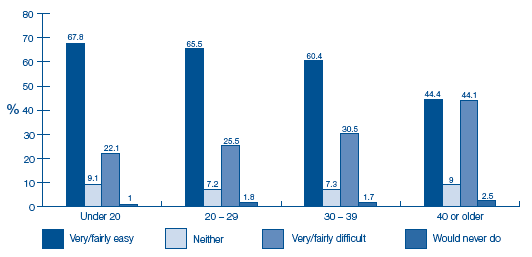
There were some small but significant differences by different area and household characteristics. Families living in areas classed as 'large urban' were most likely to have trouble arranging this type of supervision at short notice whilst respondents living in areas of higher deprivation were more likely to find making this arrangement easier than those living in areas with lower deprivation. Sixty percent of parents living in the least deprived quintile said they would find making this arrangement very or fairly easy and for 31% in the same group it would be very or fairly difficult. This compares to 65% and 27% respectively for those parents living in the most deprived quintile.
Differences by ethnicity, although following the same trend as above, were a little more pronounced for this arrangement. In the baby cohort, just under two-thirds (63%) of white respondents said this arrangement would be easy to organise compared with a little under half (48%) of non-white respondents who said the same.
5.3.3 Leaving the child with someone overnight
Arranging at short notice to leave the child with someone overnight was slightly more difficult again for parents, although the majority in both cohorts (58%) continued to say that they would find this very or fairly easy. There were no statistically significant differences between cohorts.
Differences between first-time mothers and mothers with other children were rather more stark on this item. Around two-thirds (65%) of primaparous mothers said overnight care would be very or fairly easy to arrange compared with just over half (51%) of multiparous mothers. The differences between mothers of different ages persisted; those aged 40 or older were twice as likely as those under 20 to say they would find it very or fairly difficult to arrange overnight care for their child.
Sixty percent of respondents living in the most deprived quintile said it would be very or fairly easy to make these arrangements compared with 55% of those living in the least deprived quintile. The patterns by ethnic group identified above were present again in this data. Notably however, around one-fifth of non-white parents (19%) said that they would not arrange for their child to stay overnight without them, compared with around one in 20 white parents (6%).
5.3.4 Main source of informal support/short-notice childcare
Parents were asked who they would be most likely to call on for help with looking after the cohort child. The responses by sample type are shown in Figure 5-G. By far the most common source of support of this kind were grandparents, and especially maternal grandparents. Friends or neighbours of the respondent, and parents' siblings were the next most common sources of informal support in this context.
Figure 5-G Person(s) who respondent would call on in the first instance for help with looking after the sample child by sample type
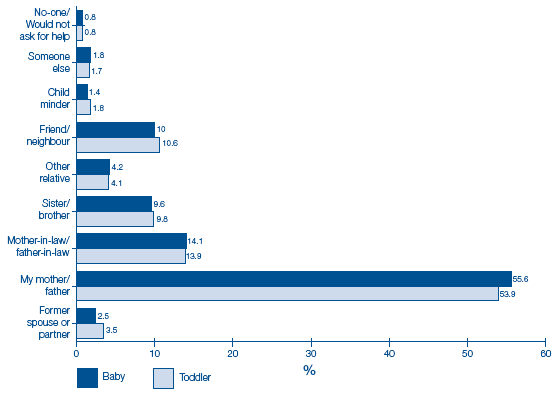
As might be expected, older mothers were less likely to name the child's grandparents as their main source of support - only around a quarter (27%) of those over 30 did so, compared with two-thirds of mothers (65%) aged under 20 and 59% of mothers in their twenties. In contrast, one in four mothers aged 40 or older named a friend or neighbour as their main source of informal support compared with 4% and 7% of mothers in the two youngest age groups respectively.
Although grandparents continued to be the dominant source of support for respondents living in areas with different urban/rural classifications, respondents living in rural areas were significantly more likely to name friends or neighbours as the person they would be most likely to call on than respondents in other areas. Parents living in areas of lower deprivation were also more likely to say they would call on a friend or neighbour in the first instance than parents in more deprived areas did. In contrast, parents in more deprived areas were more likely to draw on a sibling or other relative for help.
Some key variations by ethnicity are evident in these data. Whilst the three main sources - grandparents, siblings and friends/neighbours - are the same, the balance is different. For example, non-white respondents were just as likely to use maternal as paternal grandparents (25% maternal, 23% paternal) for care whilst white respondents tended to use maternal grandparents considerably more than paternal grandparents (56% maternal, 14% paternal). Non-white parents were also around twice as likely as white parents to use friends or neighbours (18% compared with 10%).
5.4 Involvement of non-resident parents
In Chapter 2 , it was shown that around a fifth (18%) of children in the baby sample and a quarter (24%) of children in the toddler sample had a non-resident natural parent. Approximately two-thirds (70% of babies and 68% of toddlers) had some contact with that parent at the time of the interview or were 'involved'. These cases were explored further using questions which asked about the nature of the relationship and contact between the sample child and the non-resident parent.
The majority of non-resident parents of babies were reported by the respondent to be either 'very interested' (62%) or 'somewhat interested' (19%) in the child (Figure 5-H). This differed slightly from parents of toddlers, around half of whom were said to be 'very interested', with just under a quarter 'somewhat interested' in the child. Furthermore, 15% of non-resident parents in the toddler sample were said to be 'not at all interested', compared with 10% of parents within the baby sample.
Figure 5-H Non-resident parent's interest in child by sample type
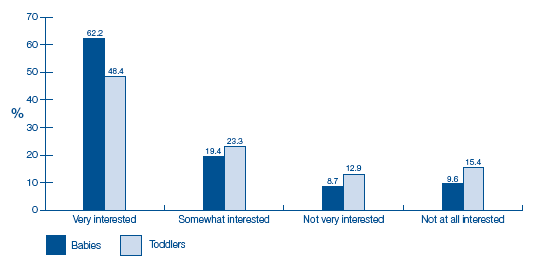
5.4.1 Types of contact with non-resident parents
Respondents were asked about the type and frequency of contact between the non-resident parent and the sample child (Table 5.3). Non-resident parents of toddlers were slightly more likely to have the child to stay at least once a month (47% compared with 40% of non-resident parents of babies). However, a large proportion of non-resident parents (53% in the baby cohort and 43% in the toddler cohort) never had the child to stay overnight.
Many non-resident parents took the child on outings or day trips at least once a week (55% of parents of babies and 48% of parents of toddlers), with a further 12% and 18%, respectively, taking the child out at least once a month. Around a quarter of non-resident parents in both cohorts never took their child out on outings or day trips.
Table 5.3 Types and frequency of contact with non-resident parent by sample type
| Sample type (% of involved non-resident parents) |
|||
|---|---|---|---|
| Baby |
Toddler |
All |
|
| Child stays overnight… |
|||
| Every day or almost every day |
2.2 |
2.2 |
2.2 |
| At least once a week |
30.5 |
34.6 |
32.1 |
| At least once a month |
9.1 |
12.4 |
10.4 |
| At least once every three months |
2.8 |
2.1 |
2.5 |
| Less often than once every three months |
2.4 |
5.9 |
3.8 |
| Never |
53.1 |
42.8 |
49.0 |
| Takes child on trips/outings… |
|||
| Every day or almost every day |
8.3 |
3.1 |
6.3 |
| At least once a week |
46.9 |
44.7 |
46.0 |
| At least once a month |
12.4 |
17.7 |
14.5 |
| At least once every three months |
1.8 |
6.0 |
3.4 |
| Less often than once every three months |
3.9 |
4.8 |
4.2 |
| Never |
26.6 |
23.7 |
25.5 |
| Bases |
|||
| Weighted |
746 |
491 |
1237 |
| Unweighted |
685 |
462 |
1147 |
5.4.2 Non-resident parent's financial contribution to the cohort child's maintenance
The main respondent was asked about any financial contribution made by the non-resident parent. Non-resident parents of babies were slightly more likely to make contributions to the child's maintenance (41% making regular contributions and 13% making irregular contributions, compared with 39% and 11% among non-resident parents of toddlers). But, overall, around half of non-resident parents in both groups paid nothing towards their child's maintenance. There appeared to be a relationship between non-resident parent's contributions to maintenance and the socio-economic class and income of the household in which the child is resident - though without demographic information about the non-resident parent it is difficult to establish the direction of the relationship. However, the data does show that non-resident parents of children in managerial and professional households were most likely to make contributions towards the child's maintenance (59% compared with 49% of those in semi-routine and routine occupations).
Respondents were also asked how often the non-resident parent bought clothes, toys or equipment for the child, apart from on special occasions such as birthdays. The majority of non-resident parents bought these items at least once a month (64% of babies' parents and 50% of toddlers' parents), with a large proportion doing so at least once a week (31% and 22% respectively). Only a fifth of non-resident parents of babies never bought these items, in contrast to nearly a third of non-resident parents of toddlers.
5.4.3 Respondent's relationship with non-resident parent
The research also explored the relationship between the child's main carer and the non-resident parent, highlighting some interesting differences by cohort. The relationship was described by parents in the baby cohort as 'very good' or 'fairly good' in 32% and 30% of cases, respectively. As Figure 5-I indicates, this contrasts with the toddler sample, where only 19% of main carers said they had a 'very good' relationship with the child's other parent, although 29% had a 'fairly good' relationship. Furthermore, nearly one in five parents of toddlers felt that they had a 'very bad' relationship with the non-resident parent, compared with one in ten parents of babies. This suggests that relationships between resident and non-resident parents may deteriorate as the child gets older.
Figure 5-I Strength of relationship between resident and non-resident parent by sample type
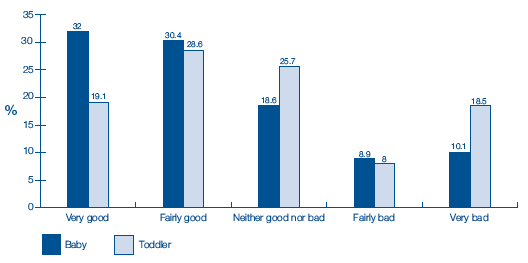
The level of interest the non-resident parent showed in the child, as discussed above (see Figure 5-H), was positively related to the strength of the relationship between the child's resident and non-resident parents. In almost all cases (98%) where the relationship was considered to be very good the non-resident parent was reported to be 'very interested' in the child. Only 6% of respondents who reported that their relationship with the child's non-resident parent was very bad also reported that the non-resident parent was very interested in the child. In these cases, the non-resident parent was significantly more likely to be not very (25%) or not at all interested (54%) in the child.
5.5 Knowledge of key government supported initiatives aimed at parents and families
Parents were asked a number of questions about various government supported initiatives that are aimed at helping parents and families. For each scheme the respondent was asked whether they had heard of it, and if they had, how much they felt they knew about the scheme and how it operates.
5.5.1 Working Families' Tax Credit
Working Tax Credit tops up the earnings of working people (employed or self-employed) on low incomes, including those who do not have children. For those who do have children, extra amounts are payable to help towards the costs of qualifying childcare.
Overall awareness of Working Families' Tax Credit was very high, with nine out of ten respondents in both samples saying they had definitely heard of it or thought they had heard of it. Actual knowledge of how the scheme operates was notably lower however. Over half of parents who had heard of it said they didn't know much about it including a small proportion who knew nothing about how it operated.
Table 5.4 Knowledge and awareness of Working Families' Tax Credit by sample type
| Level of knowledge and awareness |
Sample type (%) |
|
|---|---|---|
| Baby |
Toddler |
|
| Can you tell me if you have heard of Working Families' Tax Credit before now? |
||
| I've definitely heard of it |
81.8 |
82.4 |
| I think I've heard of it |
10.6 |
9.8 |
| I don't think I've heard of it |
2.3 |
2.4 |
| I definitely haven't heard of it |
5.3 |
5.4 |
| Bases |
||
| Weighted |
5217 |
2858 |
| Unweighted |
5217 |
2858 |
| How much would you say you know about Working Families' Tax Credit and how it operates? |
||
| I know a great deal about it |
9.7 |
10.5 |
| I know quite a lot about it |
32.1 |
33.9 |
| I don't know very much about it |
50.1 |
49.2 |
| I know nothing at all about it |
8.1 |
6.4 |
| Bases |
||
| Weighted |
4816 |
2635 |
| Unweighted |
4828 |
2640 |
Given the high level of awareness of the scheme, it is unsurprising that there were few significant differences in level of awareness across the sample. However, level of maternal education did have some affect - those with no qualifications were significantly less likely to say they had heard of the scheme. The most stark distinction in awareness of this policy was between families with at least one parent employed and those where no parents were employed (87% compared with 71%).
There was little variation across the sample in the level of knowledge among those who had heard of the scheme.
5.5.2 Child Trust Fund
Child Trust Fund ( CTF) is a savings and investment account for children. Children born on or after 1 September 2002 receive a £250 voucher from the Government to start their trust fund. The account belongs to the child and cannot be touched until they turn 18. Children in low income families receiving Child Tax Credit receive an extra payment. All children receive a further payment around their 7th birthday.
Responses on levels of knowledge and awareness of Child Trust Funds are illustrated in Table 5.5. Awareness of Child Trust Funds was almost universal across the entire sample - 99% of babies' parents and 96% of toddlers' parents having heard of the scheme. Level of knowledge of the scheme and how it works was also generally high and again differed slightly by sample. Of those who had heard of the scheme, 69% of babies' parents and 62% of toddlers' parents knew quite a lot or a great deal about CTFs and how they work.
Table 5.5 Knowledge and awareness of Child Trust Funds by sample type
| Level of knowledge and awareness |
Sample type (%) |
|
|---|---|---|
| Baby |
Toddler |
|
| Can you tell me if you have heard of the Child Trust Fund before now? |
||
| I've definitely heard of it |
95.1 |
89.9 |
| I think I've heard of it |
3.5 |
6.4 |
| I don't think I've heard of it |
0.4 |
1.0 |
| I definitely haven't heard of it |
1.0 |
2.8 |
| Bases |
||
| Weighted |
5217 |
2858 |
| Unweighted |
5217 |
2858 |
| How much would you say you know about the Child Trust Fund and how it operates? |
||
| I know a great deal about it |
19.2 |
17.8 |
| I know quite a lot about it |
49.6 |
43.8 |
| I don't know very much about it |
28.9 |
33.8 |
| I know nothing at all about it |
2.3 |
4.6 |
| Bases |
||
| Weighted |
5142 |
2752 |
| Unweighted |
5147 |
2749 |
As awareness of the scheme was extremely high across the sample as a whole, there were few variations of note by subgroup. Some more revealing distinctions are evident, however, in extent of knowledge about the scheme and how it operates. Parents in couple families, older mothers and those with higher educational qualifications reported greater knowledge of the Child Trust Fund than lone parents, younger mothers and those with no educational qualifications. For example, around half (48%) of respondents with no formal qualifications said they had little or no knowledge compared 23% of degree-educated mothers and 27% of those with Higher grades.
5.5.3 SureStart Scotland
SureStart Scotland aims to support families with very young vulnerable children to ensure they have the best possible start in life, helping them to get the most from subsequent opportunities such as pre-school education. The SureStart Scotland programme is targeted at vulnerable children and families and is delivered through a range of intensive, group and resource-based services, in each local authority area. Intensive provision might involve home based support; group provision might provide training and crèche facilities; and resource provision might involve a toy library or books. Many services are provided via a SureStart Centre and some are not explicitly operated under the SureStart banner.
Table 5.6 Knowledge and awareness of SureStart by sample type
| Level of knowledge and awareness |
Sample type (%) |
|
|---|---|---|
| Baby |
Toddler |
|
| Can you tell me if you have heard of the SureStart programme before now? |
||
| I've definitely heard of it |
16.0 |
15.1 |
| I think I've heard of it |
16.4 |
15.1 |
| I don't think I've heard of it |
12.1 |
11.7 |
| I definitely haven't heard of it |
55.5 |
58.1 |
| Bases |
||
| Weighted |
5217 |
2858 |
| Unweighted |
5217 |
2858 |
| How much would you say you know about the SureStart programme and how it operates? |
||
| I know a great deal about it |
6.6 |
6.8 |
| I know quite a lot about it |
17.4 |
18.3 |
| I don't know very much about it |
50.9 |
47.2 |
| I know nothing at all about it |
25.1 |
27.7 |
| Bases |
||
| Weighted |
1689 |
863 |
| Unweighted |
1689 |
863 |
As the data in Table 5.6 show, awareness of the SureStart Scotland programme was generally low in both cohorts although this is perhaps unsurprising given its targeted rather than universal nature. Over half of the parents in each sample said they had definitely not heard of it. Among those who had heard of SureStart, the level of knowledge about the programme was also very low. Most respondents admitted that they did not know very much about it and around a quarter in each cohort said they knew nothing about it at all.
There were no significant differences in awareness of SureStart according to level of area deprivation, but awareness was higher among respondents who lived in areas classed as remote or rural than among those who lived in urban areas or small accessible towns. Half of parents (48%) living in remote rural areas said they had heard of SureStart - almost twice the proportion in large urban areas (28%).
Actual knowledge of the programme among those who had heard of it was slightly higher among lone parents and younger mothers. Twenty-nine percent of lone parents and 28% of mothers aged under 20 knew quite a lot or a great deal about SureStart compared with 23% of parents in couple families and 23% of mothers in their thirties. Despite a greater awareness of the scheme, parents living in areas classed as remote or rural were not significantly more likely to know any more about how SureStart operated than parents living in other areas.
5.5.4 ParentLine Scotland
General awareness of ParentLine Scotland, a telephone helpline offering advice and information for parents, was relatively low although more parents were aware of this scheme than were aware of SureStart. About half of the respondents in both cohorts (53% babies' parents, 50% toddlers' parents) said they definitely hadn't heard of ParentLine Scotland and around one in five parents said that they definitely had. Knowledge of the scheme among those who had heard of it was limited. In each cohort, less than 10% of parents who had heard of the scheme said they knew a great deal or quite a lot about it. The majority admitted that they did not know very much about ParentLine Scotland.
Table 5.7 Knowledge and awareness of ParentLine Scotland by sample type
| Level of knowledge and awareness |
Sample type (%) |
|
|---|---|---|
| Baby |
Toddler |
|
| Can you tell me if you have heard of ParentLine Scotland before now? |
||
| I've definitely heard of it |
18.1 |
20.6 |
| I think I've heard of it |
20.1 |
21.0 |
| I don't think I've heard of it |
8.8 |
8.6 |
| I definitely haven't heard of it |
52.9 |
49.8 |
| Bases |
||
| Weighted |
5217 |
2858 |
| Unweighted |
5217 |
2858 |
| How much would you say you know about ParentLine Scotland and how it operates? |
||
| I know a great deal about it |
1.5 |
1.1 |
| I know quite a lot about it |
7.3 |
7.8 |
| I don't know very much about it |
56.2 |
58.0 |
| I know nothing at all about it |
35.0 |
33.2 |
| Bases |
||
| Weighted |
1994 |
1188 |
| Unweighted |
2018 |
1204 |
First-time mothers were less likely than those who already had other children to say they had heard of Parentline Scotland (57% compared with 47). Maternal age at the time of birth was also related to level of awareness. Older mothers were significantly more likely than younger mothers to have heard of the scheme. A quarter of mothers aged 40 or over at the time of the child's birth said they had definitely heard of ParentLine Scotland - twice as many as among the youngest age group (13%). Awareness of Parentline also varied by area deprivation levels - parents living in less deprived areas were more likely to say they had heard of this service than parents living in more deprived areas.
There were no notable statistically significant variations across the sample in level of knowledge about Parentline Scotland among those who had heard of it.
5.5.5 Childcare Link website and phone line 16
The ChildcareLink helpline and website were launched in December 1999 as part of the National Childcare Strategy. This strategy aims to help people back into the workplace by removing the childcare barrier. The ChildcareLink national website provides childcare and early years information collected from Scottish local authorities. This information is designed to allow parents to make informed choices about care for their child.
The Childcare Link website and phone line was the least known scheme of all those asked about. A little over three-quarters of parents in both cohorts said they definitely hadn't heard of the scheme and only 6% were confident that they had. Knowledge of the scheme among those who had heard of it was a little less limited although still quite low. Around a third of parents who had heard of Childcare Link said they knew quite a lot or a great deal about it, although 52% knew 'not very much' and 15% 'nothing at all'.
Table 5.8 Knowledge and awareness of Childcare Link by sample type
| Level of knowledge and awareness |
Sample type (%) |
|
|---|---|---|
| Baby |
Toddler |
|
| Can you tell me if you have heard of the Childcare Link website and phone line before now? |
||
| I've definitely heard of it |
6.0 |
6.2 |
| I think I've heard of it |
5.3 |
4.8 |
| I don't think I've heard of it |
10.7 |
11.3 |
| I definitely haven't heard of it |
78.0 |
77.7 |
| Bases |
||
| Weighted |
5217 |
2858 |
| Unweighted |
5217 |
2858 |
| How much would you say you know about the Childcare Link website and phone line and how it operates? |
||
| I know a great deal about it |
8.6 |
8.4 |
| I know quite a lot about it |
24.9 |
25.6 |
| I don't know very much about it |
51.9 |
51.7 |
| I know nothing at all about it |
14.7 |
14.4 |
| Bases |
||
| Weighted |
589 |
314 |
| Unweighted |
607 |
318 |
Not surprisingly, levels of awareness of Childcare Link were generally low across the whole sample. However, awareness of the scheme was higher among respondents in couple families, older mothers and those in employment than among lone parents, younger mothers and those unemployed. Seventeen percent of mothers who were employed full-time said they had definitely or thought they had heard of the scheme compared with 13% of mothers who worked part-time and 8% of mothers who were unemployed.
Among mothers who had heard of the scheme some of these patterns are reversed. For example, almost half (47%) of mothers aged under 20 said they knew quite a lot or a great deal about Childcare Link compared with 21% of mothers aged 40 or older. However, mothers who were employed full-time had a higher level of knowledge about it than those employed part-time and those who were unemployed.
Given that one of the aims of Childcare Link is to provide local information about childcare provision, analysis was undertaken to examine whether those respondents currently using childcare were more aware of the scheme than those who were not using childcare. The results showed that parents using childcare were slightly more likely to have heard of the scheme than parents who were not using childcare (12% compared with 9%). Levels of knowledge of the scheme among those who had heard of it was also slightly higher among parents who were using childcare than among those who were not.
5.5.6 NHS 24
NHS 24 is a confidential telephone service providing health advice and information for people in Scotland.
Overall awareness of NHS 24 was very high (at around 90%) - indeed, only Child Trust Funds had been heard of by more parents. The majority of parents who had heard of NHS 24 were also well versed in what the scheme was and how it operated. Around three-quarters of parents in both cohorts said they knew a great deal or quite a lot about the service, the highest knowledge figures for all the schemes considered.
Table 5.9 Knowledge and awareness of NHS 24 by sample type
| Level of knowledge and awareness |
Sample type (%) |
|
|---|---|---|
| Baby |
Toddler |
|
| Can you tell me if you have heard of the NHS 24 phone line before now? |
||
| I've definitely heard of it |
91.3 |
89.8 |
| I think I've heard of it |
2.8 |
3.5 |
| I don't think I've heard of it |
0.8 |
0.9 |
| I definitely haven't heard of it |
5.1 |
5.7 |
| Bases |
||
| Weighted |
5217 |
2858 |
| Unweighted |
5217 |
2858 |
| How much would you say you know about the NHS 24 phone line and how it operates? |
||
| I know a great deal about it |
26.6 |
29.2 |
| I know quite a lot about it |
47.7 |
45.7 |
| I don't know very much about it |
23.3 |
23.3 |
| I know nothing at all about it |
2.4 |
1.8 |
| Bases |
||
| Weighted |
4910 |
2665 |
| Unweighted |
4918 |
2671 |
Despite the overall high proportion of respondents who had heard of NHS 24, there were some variations in levels of awareness following patterns already well established in these data. Lone parents, mothers in the youngest age group and those who had no qualifications were less likely to have heard of the service than other mothers as were those living in more deprived areas.
Knowledge of the scheme and how it operated were higher in households where the child's mother was employed full-time compared with those where she was employed part-time or unemployed. There was also some variation in knowledge of the scheme by household socio-economic classification. Parents in households classed as managerial and professional reported a higher level of knowledge about NHS 24 than those in household classed as routine or semi-routine.
5.5.7 The Children's Traffic Club
The Children's Traffic Club provides a structured way for parents and carers to teach their three to four-year-old children basic road safety skills through a series of free books that are delivered to the child's home. The scheme operates throughout the UK in partnership with Local and Health Authorities. Given the age restrictions which apply to the Children's Traffic Club, questions about the scheme were asked only of parents of children in the toddler cohort.
Bearing in mind that children in the toddler cohort were not quite three years old at the time of the interview, awareness of the Children's Traffic Club was reasonably high. Half of the parents in the toddler sample said they had heard of the scheme including 41% who had definitely heard of it. Most parents who had heard of the scheme had a reasonable amount of knowledge about it. Fifty-eight percent said they knew quite a lot or a great deal about it and only 6% admitted knowing nothing at all.
Table 5.10 Knowledge and awareness of the Children's Traffic Club by sample type
| Level of knowledge and awareness |
Sample type (%) |
|---|---|
| Toddler |
|
| Can you tell me if you have heard of the Children's Traffic Club before now? |
|
| I've definitely heard of it |
40.6 |
| I think I've heard of it |
10.3 |
| I don't think I've heard of it |
4.8 |
| I definitely haven't heard of it |
44.4 |
| Bases |
|
| Weighted |
2858 |
| Unweighted |
2858 |
| How much would you say you know about the Children's Traffic Club and how it operates? |
|
| I know a great deal about it |
17.6 |
| I know quite a lot about it |
40.7 |
| I don't know very much about it |
35.2 |
| I know nothing at all about it |
6.4 |
| Bases |
|
| Weighted |
1452 |
| Unweighted |
1475 |
The relevance of the child's age to the scheme no doubt explains the fact that awareness of the Traffic Club was much lower among first-time mothers than among those with other children, since mothers in the latter group may have previously received information about the traffic club in relation to another, older child. Some other significant differences are perhaps less obviously explained. For example, there was some slight variation in reported awareness by parents living in different urban and rural areas. Respondents from areas classed as accessible rural were most likely to say they had heard of the scheme (59% had heard of it) whereas respondents who lived in areas classed as large urban or small, remote towns were least likely to have heard of it (47% and 48% respectively).
Greater variation was evident in levels of knowledge among those parents who had heard of the scheme. Sixty-two percent of parents in couple families said they knew quite a lot or a great deal about the traffic club compared with 47% of lone parents. Eighteen percent of mothers who were aged under 20 at the time of the child's birth said they didn't know anything about the scheme - a figure twice that for mothers in their twenties and almost six times higher than for mothers in their thirties. Some variation in knowledge existed across parents living in areas with different deprivation levels with knowledge levels lower among parents who lived in the two most deprived quintiles than those living in other areas.
5.6 Attendance at groups and classes for parents and children
Parents were asked whether they had attended any mother and baby or mother and toddler groups in the last year. In cases where the respondent had not attended any such groups, they were asked why not. They were also asked about attendance at parenting classes or groups 'where parents have the chance to improve their parenting skills and knowledge' in the last year, the usefulness of these classes or groups and who attended (either parent or both).
5.6.1 Parent and baby/toddler groups
Around 40% of parents in both samples said they had attended a parent and baby or parent and toddler group in the last year. Attendance was slightly higher in the toddler cohort (43% compared with 39%).
In both cohorts, mothers from couple families and older mothers were more likely to say they had attended a group in the last year than lone mothers and younger mothers. In the toddler cohort for example, 47% of mothers in couple families said they had attended a group compared with 29% of lone mothers and 47% of mothers in their thirties had attended a group compared with 28% of mothers aged under 20. Mothers with only one child in the household were also significantly more likely than mothers with other children to have attended a group in the last year.
Interestingly, parents in remote towns and remote rural areas were almost twice as likely as those in urban areas to have attended baby and toddler groups (Figure 5-J). Although attendance rates were similar across the three least deprived area quintiles, they dropped significantly among parents in areas which fell into the two most deprived quintiles.
Figure 5-J Attendance at mother and baby/toddler groups by area urban/rural classification
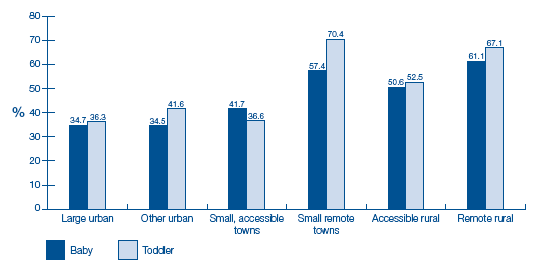
Attendance was also lower among parents in households where no adults were employed: in the baby cohort, for example, a fifth (22%) of parents in unemployed households said they had attended a group, around half as many as in households where at least one parent was employed full or part-time. Parents living in households classed as managerial or professional were the most likely of those in all socio-economic classifications to have attended a group in the last year. In the baby cohort, half the respondents in this classification said they had attended such a group compared with a third of those in households classed as lower supervisory and technical and a quarter of those living in households classed as routine or semi-routine.
The reasons given for non-attendance are displayed in Figure 5-K below. The most common reason given by parents in both cohorts was lack of time - mentioned by around a third of those who had not attended classes. Over one in ten said it was because there were no classes available or accessible to them. Many parents simply didn't want to attend and a significant proportion either felt shy or awkward about attending or said they didn't like groups. Parents of children in the baby cohort who did not attend groups were more likely than those in the toddler cohort to say it was because of lack of knowledge or information about such classes.
The pattern of reasons given for not attending varied by respondent, family and household characteristics. Lone parents, younger mothers and first-time mothers, for example, were more likely to mention feeling awkward and shy about attending a group, along with a dislike of groups in general, as reasons for non-attendance. Lone parents were also less likely to give a lack of time as reason, as were younger mothers and first-time mothers. In addition, mothers in the two youngest age groups were significantly more likely to say that nobody had told them or they had no information about any such groups.
Figure 5-K Reasons given for not attending mother and baby or mother and toddlers groups by sample type
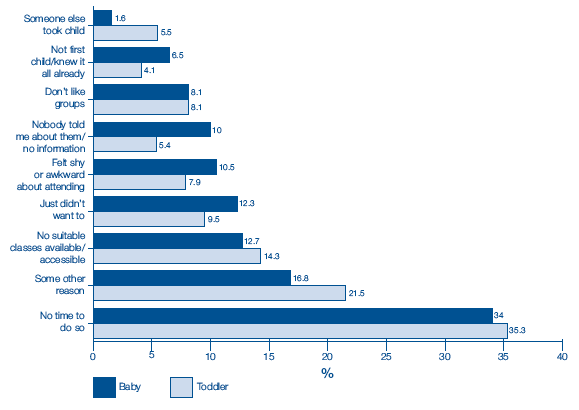
5.6.2 Parenting classes
Respondents were also asked whether they had attended any parenting classes or groups 'where parents have the chance to improve their parenting skills and knowledge'. Those who had were asked how useful they found the classes.
Only a very small proportion of parents in each cohort said they had attended a parenting class or group in the last year - 4% of babies' parents and 3% of toddlers' parents. There were no statistically significant variations in attendance by any key respondent, family or household characteristics. In a little under two-thirds of cases the child's mother attended the classes on her own. For the remainder the child's mother and father attended.
Almost all who had attended a parenting class or group reported that they found it to be very useful (52%) or fairly useful (41%). Given the small numbers involved and the strong favourable pattern in response, there is little statistically significant variation in appraisals of the usefulness of parenting classes across the sample.
5.7 Key points
- Most children had some contact with all of their grandparents and contact with grandparents was a generally frequent occurrence for the majority of children. Children in couple families, those with older mothers, those living in less deprived areas and those in remote rural areas were more likely to have some contact with all of their grandparents. However, children in lone parent families, those with younger mothers and those living in more deprived areas saw their grandparents more often.
- Grandparents helped out in a variety of ways. Providing childcare and buying things for the child were the two most common forms of support provided. Respondents from lone parent families, primaporous mothers and younger mothers reported higher levels of support from the child's grandparents.
- Arranging last-minute childcare was easy for most parents. However, it was significantly easier for younger mothers, first-time mothers and those living in areas of higher deprivation to arrange. The child's grandparents were the most commonly reported source of this type of care.
- Knowledge and awareness among parents of key blanket schemes for children and families such as Child Trust Funds, NHS24 and Working Families' Tax Credit was particularly high, as might be expected. However, the awareness of other nationally accessible but more focused schemes such as Childcare link and Parentline Scotland was extremely low.
- Around two-fifths of respondents had attended a mother and child group in the last year. Likelihood of attendance was lower among young mothers and lone parents who cited awkwardness and shyness as key inhibitors.
- While only a small proportion (less than 5%) of respondents had attended a parenting class in the last year, virtually all of those who did so found it to be useful.
5.8 Conclusion
The high proportion of parents who are in contact with four of the children's grandparents and the frequency of contact between children and one or more grandparent demonstrates the potential importance of grandparents in children's lives. The data confirm that the majority of parents receive some support for their parenting from their own parents. The construction of an index of grandparents' support makes it possible to show that young lone mothers receive the highest levels of support. This suggests that children in families with young lone mothers where there is no involved grandparent experience a particularly serious deficit. The data indicate that some structural factors reduce children's access to their grandparents (and parents' access to support from their child's grandparents). Although children born to young lone mothers typically have frequent contact with at least one grandparent, they are also less likely to have contact with all four grandparents. This is not surprising given that their mothers were not typically in an established partnership prior to their birth. The data also indicate that geographical location has some impact on children's access to grandparents, not withstanding the fact that the majority of children in remote rural areas are as likely to have contact with all grandparents and very regular contact with some grandparents as those in urban areas. The small proportion who have relatively little contact with their grandparents (less than once a month) in remote rural areas is significantly higher than it is in urban areas (just over a fifth of toddlers in remote rural areas compared with one out of ten in large urban areas). Furthermore, it is likely that due to the constraints of geographical distances, parents in remote rural areas receive lower levels of support from grandparents than those in other areas.
Many parents have limited knowledge of a range of services and policies specifically aimed at supporting their parenting and their child's development. Unlike with informal support, there is no obvious match between need of support and the likelihood of receiving it. It is not surprising that the SureStart programme is not well known to parents as the range of services funded by SureStart are not only targeted at a particular group of vulnerable children but are also delivered locally in many shapes and forms that are not necessarily identified as Sure Start. However, it seems that the web-based and phone line services that seek to be accessible (Parentline Scotland and Childcare Link) need a much higher profile if they are be part of the repertoire of resources available to the majority of parents, including parents in more disadvantaged circumstances. As research on service use has demonstrated, knowledge of services, often a prerequisite to accessing their support, varies with levels of education and socio-economic status. The better educated and more advantaged mothers are the most informed. As well as typically lacking the advantages of high levels of education and income, lone parents, by definition, are without a co-resident partner to act as another pair of ears. Lone parents and young first-time mothers are less likely to have information about services and to know about and attend mother and baby or mother and toddler groups. They were also more likely to feel shy or awkward about attending if they were aware of such groups.
There is a problem
Thanks for your feedback